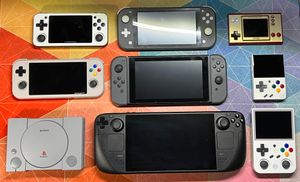Fun with Retro Handhelds
February 21, 2023
My son Ryan recently turned four years old and had a Super Mario-themed birthday. In the past six months or so he's gone from being obsessed with Thomas the Tank Engine to becoming obsessed with Mario. He was Mario for Halloween and has Mario-themed bedding topped with a metric ton of Mario plushes, or "stuffies."
How did we get here?
It all started when he spotted a Nintendo Game and Watch with the original NES Super Mario Bros. on it. He asked me what it was and I let him try it out and he was instantly hooked. After about a month, he beat level 1-1 all by himself. He was so excited!
Super Mario Bros. is an all-time classic. It's really a master class in game design. You learn the mechanics in a very subtle way and each level adds new enemies and traps and requires you to learn new ways to beat them. But when you think about it, it's also really challenging, particularly for a (then) three-year-old. It's like the Dark Souls of platformers.
In the mid-80s, we were still in the heyday of arcade games and those games were designed to get you to keep pumping quarters into the machine. Super Mario Bros. follows this same pattern, starting you with three lives. If you use up those lives, you have to start over from the beginning.
So for Christmas I was thinking about how to transition him to more forgiving Mario games like Super Mario World on SNES. Super Mario World had a lot more opportunites to get extra lives and also allowed to you save your progress. For my money it's still the perfect Mario game.
I had heard about a number of retro handheld devices that were gaining popularity and decided to check a few out to see which one might be a good fit for Ryan and, well, let's just say I got a little carried away.

Middle row: Retriod Pocket 3+, Nintendo Switch, Miyoo Mini v2
Bottom row: PlayStation Classic, Valve Steam Deck, Anbernic RG353V
An embarassingly large collection of retro handhelds 😳
Here are a bunch of devices I now own that can play a ton of games from past generations of gaming systems. There's a pretty wide range of pros/cons and price points, but if you're interested in reliving your childhood with some classic games, you should find something here that fits your needs/budget.
Nintendo Game and Watch
$45
These come in two different flavors — Mario and Zelda. The Mario one comes with Super Mario Bros., Super Mario Bros: The Lost Levels (a freakishly hard successor to SMB that originated in Japan as Super Mario Bros 2), and a classic Game and Watch juggling game.
The Zelda one comes with The Legend of Zelda, Zelda II: The Adventure of Link, and The Legend of Zelda: Link's Awakening, as well as a classic Game and Watch whack-a-mole-type game.
I love the retro aesthetic of these but for not much more money you can get a device that can play all of these games and hundreds more.
Miyoo Mini v2
$70
The Miyoo Mini v2 was the first device I bought and ultimately the one I decided to give to Ryan for Christmas. It's incredibly small and fits easily into just about any pocket. It might even be too small for an adult's hands but for Ryan it's perfect. It looks like a super tiny Game Boy and I love it.

This thing can play just about any console up to PlayStation 1, including NES, SNES, Genesis, Game Boy and Game Boy Advance, to name a few. Like many of the cheaper handhelds, it comes pre-loaded with a bunch of games, but a lot of them are junky and the games are arbitrarily numbered instead of listed alphabetically.
With a little bit of effort, you can find and load just about any game you can think of relatively easily. There's also a number of different custom operating systems you can load onto the Miyoo Mini. I went with MiniUI, which is a super-minimal OS created by Shaun Inman. It's a intuitive enough for a toddler to figure out.
The biggest drawback of the Miyoo Mini v2 is it's availability. While the original MSRP is about $70, it's been incredibly hard to come by because of its popularity combined with supply chain issues. It was recently discontinued in favor of the upcoming Miyoo Mini v3, which includes a larger screen. You can still find these, but expect to pay double or even triple the list price.
Anbernic RG35XX
$56
A better bet might be the Anbernic RG35XX. Similarly priced to the Miyoo Mini, the RG35XX is slightly larger but has a similar form factor and supports pretty much the same consoles (if not more). It also supports wireless and wired external gamepads and includes an HDMI out so you can hook it up to a TV. Best of all, you can actually find one for less than $60. I just ordered one of these recently, as if I didn't have enough handhelds already.
Anbernic RG353V
$120
The Anbernic RG353V is almost identical to the RG35XX but can play a few newer consoles like Dreamcast and N64. It also has two analog joysticks on the bottom to support those newer consoles. You can also run Android on it and play Android games, though I haven't tested this yet. It costs twice as much as the RG35XX, but if you really want to play those other consoles, you might find it worth the extra price.
Anbernic RG351P
$95
The Anbernic RG351P is kind of in the middle, price- and feature-wise between the RG35XX and RG353V. It has its controls on the sides of the screen instead of below, giving it more of a Nintendo Switch feel. The RG351P doesn't include HDMI out but it does support the same systems as the RG353V. I kind of like the more modern form-factor of this one.
Retroid Pocket 3+
$150
I really love the form-factor of the Retroid Pocket 3+. It's very much like a smaller Nintendo Switch Lite. It's a bit more powerful than any of the Anbernic devices I've tried, allowing it to play GameCube, PS2, Nintendo Wii and 3DS games, as well as Android games. And because it's an Android device, you can download apps to stream XBox Series X and PS5 games. This might be the best retro handheld for the money.
Nintendo Switch / Switch Lite
$200 (Lite) / $300 / $350 (OLED)
While not specifically a retro handheld, the Nintendo Switch does offer a bunch of retro games via Nintendo Online for NES, SNES, N64, Game Boy and Game Boy Advance, and even Sega Genesis. While you can't play your own games, Nintendo's collections feature a lot of the best games from those systems. As an added benefit, you can play a ton of modern games on the go as well.
For Ryan's birthday party, I set up my Switch, which I hadn't played in years and loaded up a bunch of modern Mario games on it and he loves it. He's mostly bouncing between Super Mario Maker 2, Mario Kart 8, and Super Mario Bros. U Deluxe.
Valve Steam Deck
$400–$650
If money is no object, Valve's Steam Deck might be the best portable gaming device you can buy. This thing is basically a portable PC and, as such, it can emulate just about anything as well as playing triple-A PC games like Elden Ring or Spider-Man without a hitch.
I picked one up when I got my Facebook settlement money (thanks Zuck!) and it's pretty great. It's the beefiest of these handhelds, almost to the point of being unweildy, but there's almost nothing it can't do.
PlayStation Classic
$100
Finally, I saw a video where someone turned a PlayStation Classic — one of those mini retro consoles that were all the rage a few years ago — into a full-fledged retro gaming console. I happened to have one unopened in my attic so I brought it down and tried it out. It was actually pretty good and because of its USB ports, I was able to hook up a PlayStation 5 controller wirelessly. And while it isn't handheld, it might be a good option if you're looking to get into retro gaming but prefer to play on a TV.
These are discontinued but you can find them pretty easily online, sometimes even cheaper than their original $100 retail price. This might have been the biggest dud of all the retro consoles due to its weak collection of titles.
Getting Started
Many of these systems come with an underwhelming selection of games pre-loaded (if any at all), and for good reason. The legality of video game emulation is iffy, to say the least. Most articles/videos won't tell you how to get all the cool games they're demoing and will issue the disclaimer that you should only use legal backups of games you've already purchased.
But, c'mon, anyone who spent 20 minutes in the 90s downloading a single song on Napster is probably not gonna think twice about grabbing a bunch of ROMs (game files) off the Internet.
That said, I'll just say that there's a subreddit called "Roms" and they have a "megathread" and if you can find that through some kind of search engine, then you're golden.
Aside from that, there's some great content creators that have reviews and guides on many of the systems above as well as a bunch of others that are available — and there are a lot.
Retro Game Corps has the most in-depth reviews and guides I've found so far. I was able to get all the various custom operating systems and emulation software setup without much effort. They recently released a great video intro to retro handheld gaming.
Wulff Den also has great reviews and recently did one on the Anbernic RG35XX, calling it the best, cheap retro handheld that's actually available.
The irony of retro handheld gaming
So which of these devices do I play the most? None of them, really. I'm home so often that I usually opt to play on PlayStation 5. And while Ryan loves playing all these games, they're all new to him. For me, I spent months or even years playing some of them as a kid, but games evolved to the point where playing many of them now just feels tedious.
I gotta say though, a lot of Nintendo games, particularly Mario games, really hold up. I've enjoyed helping Ryan when he gets stuck and playing two-player games with him on the Switch. It's so much fun reliving my childhood through him. Even if my wife would rather I didn't. 😅
Have you dipped into retro gaming? What games are you playing? Let me know!
